In Windows 11/10, you can view NTFS permissions in different ways. Many third-party tools or software are available that will help you check NTFS permissions on your Windows computer. In addition to this, you can also use the command line tool. In this article, we will show you how to check NTFS Permissions using Command-line or Tool.
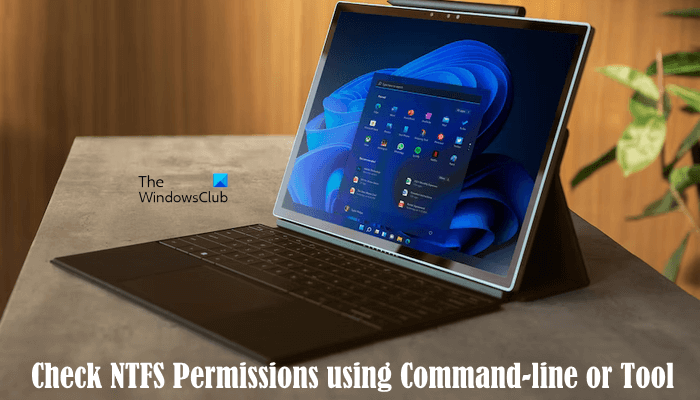
How to check NTFS Permissions using Command-line or Free tools
To check NTFS Permissions using Command-line or Tool, you can use Windows PowerShell and other free software. We have listed all these tools below.
- Windows PowerShell
- Microsoft’s AccessEnum
- Folder Security Viewer
- Permissions Reporter from Key Metric Software
- NTFS Permissions Reporter from CJWDEV
Let’s see how to use all these tools to check NTFS permissions on Windows 11/10.
1] Windows PowerShell
Windows PowerShell is a built-in command line tool that comes pre-installed in all Windows computers. You can use this tool to check NTFS permissions. The command that is used to check NTFS permissions in PowerShell is Get-Acl. We will explain here how to use this command in PowerShell in different scenarios.
First of all, launch Windows PowerShell. There are different ways to open Windows PowerShell. The easiest method is to open it via Windows Search.
You can use the Get-Acl command with and without parameters. If you use it without any parameters, Windows will show you the NTFS permissions for the current working directory. For example, if I want to check the NTFS permissions for the folder located inside my D drive, the command is:
Get-Acl D:\foldername
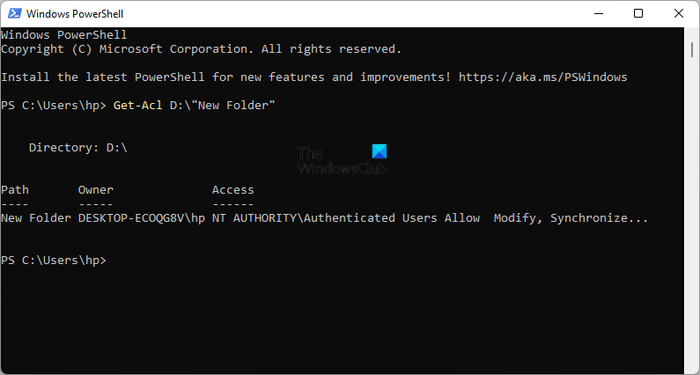
Replace the folder name in the above command with the name of your folder. If the folder name has spaces, you have to type it in quotations. For example, if the folder name is New folder, then the command will become:
Get-Acl D:\"New Folder"
Now, let’s see how to use the Get-Acl command with different parameters. In all the commands, we will use the New folder as the folder name. Replace the New folder with the name of your folder.
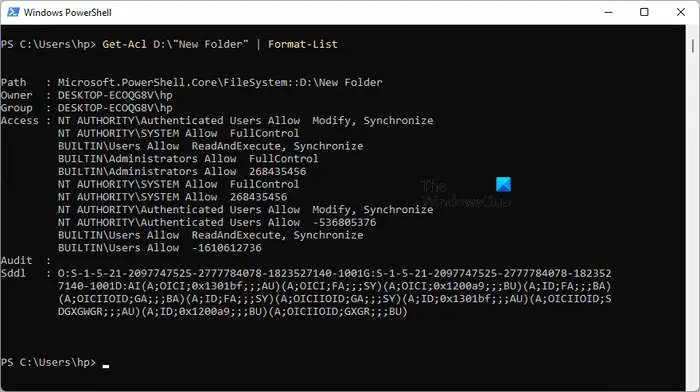
If you use the Format-List parameter, you will see the detailed permissions as shown in the above screenshot. The command Get-Acl with the Format-List parameter is as follows:
Get-Acl D:\"New Folder" | Format-List
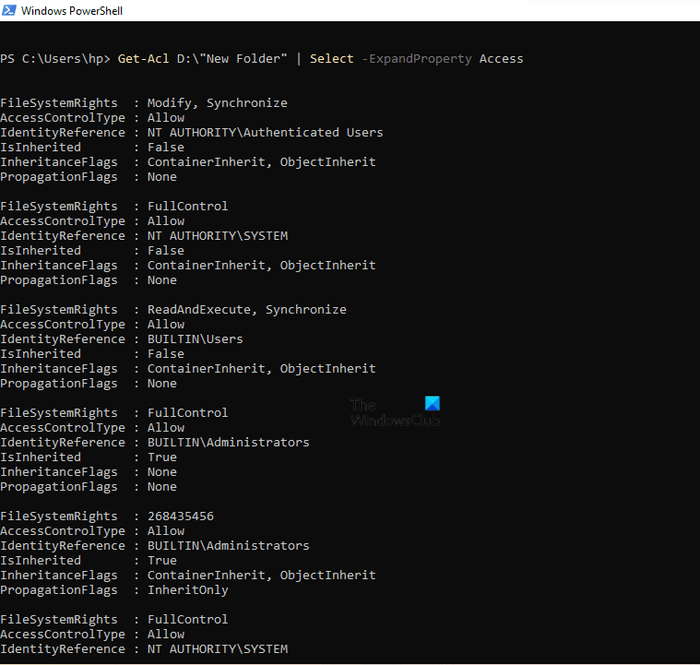
The Select -ExpandProperty Access or .Access parameters give you a more detailed view of NTFS permissions, like file system rights, access control type, inheritance flags, etc. (refer to the above screenshot). Both the parameters give you the same result but commands to use both these parameters are different. The commands are given below:
Get-Acl D:\"New Folder" | Select -ExpandProperty Access
(Get-Acl D:\"New Folder").Access
You can use any of the above commands to get more detailed NTFS permissions.

The parameter ft -AutoSize gives the NTFS permissions output in a table format. The command Get-Acl with the ft -AutoSize parameter is used as follows:
Get-Acl D:\"New Folder" | Select -ExpandProperty Access | ft -AutoSize
If you want to see the NTFS permissions for a particular user name or group, say, Administrators, SYSTEM, Authenticated users, etc, you have to specify it in the command while using the ft -AutoSize parameter. The command for this is:
Get-Acl D:\"New Folder" | Select -ExpandProperty Access | where {$_.IdentityReference -like "*user name or group*"} | ft -AutoSize
In the above command, replace the user name or group with the respective names. For example, if you want to see the NTFS permissions for Administrators, you have to type the following command:
Get-Acl D:\"New Folder" | Select -ExpandProperty Access | where {$_.IdentityReference -like "*Administrators*"} | ft -AutoSize
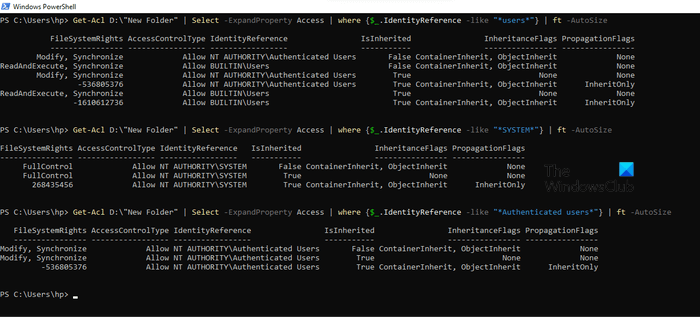
In the above screenshot, I have used the above command for three different user names, users, SYSTEM, and Authenticated users.
2] Microsoft’s AccessEnum
AccessEnum is a freeware from Microsoft that lets you check NTFS permissions on your Windows computer. You can download it from microsoft.com. It is portable software, hence, you need not install it. Just double-click on the exe file to launch the software.

Using AccessEnum, you can check the permissions of your directories and Registry. When you launch the software, you will see two options on the right side. Select the one for which you want to check the permissions. After clicking on the required option, you will be asked to select the directory or registry path. After selecting, click on the Scan button on the bottom left side. AccessEnum will scan the selected directory or registry path and show you its permissions.
You can save the permissions on your disk in text format. The “Compare to saved” is one interesting feature of this free software using which you can compare the permissions of the currently scanned directory or registry path with the saved permissions file.
Read: The Volume Bitmap is incorrect when running CHKDSK
3] Folder Security Viewer
Folder Security Viewer is available as free and paid software. Its free version comes with limited features, You can use it to view the NTFS permissions for free. Under the Home tab, you will see different options, including Permission Report, Folder Report, Owner Report, etc.
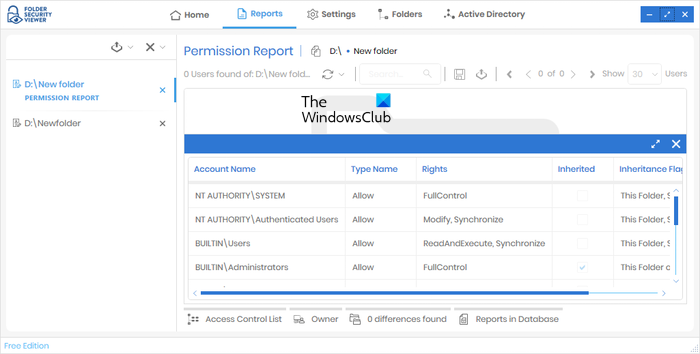
To view the NTFS permissions, select the Permission Report option and then select the directory. All the reports that you generate will be available under the Reports tab. You can select a particular report from the left side. To see all the permissions, click on the Access Control List option at the bottom.
To download Folder Security Viewer, visit foldersecurityviewer.com. You have to provide your name and email address in order to download the software. In your email, you will also receive a free trial 14 days license. After the trial license expires, you can still use its free version.
4] Permissions Reporter from Key Metric Software
Permissions Reporter is a free tool from Key Metric Software to check NTFS permissions on Windows 11/10. It is available in both free and paid versions. Its free version allows you to view NTFS permissions and access some features. If you want to access all its features, you have to purchase its license.
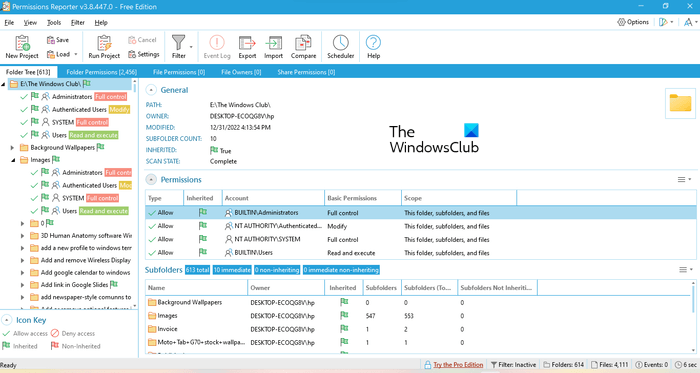
To view NTFS permissions for a particular directory, open the software and then click on the New Project option. Now, select the folder. After that, click Save and then click on the Run Project option. Permission Reporter will automatically detect all the folders and files inside the selected folder. After scanning is completed, you will see the permissions for all the files and folders inside the targeted folder. The time taken by the Permissions Reporter to scan the selected directory depends on the total number of files and folders inside that directory.
The Folder Tree tab shows the tree view of the selected directory. The Folder Permissions tab shows the permissions of all the folders inside the directory in a list view. You can also apply filters to get more specific results. The Export option is also available. But in the free version, you can export the project only in HTML format.
You can download Permissions Reporter from its official website permissionsreporter.com.
5] NTFS Permissions Reporter from CJWDEV
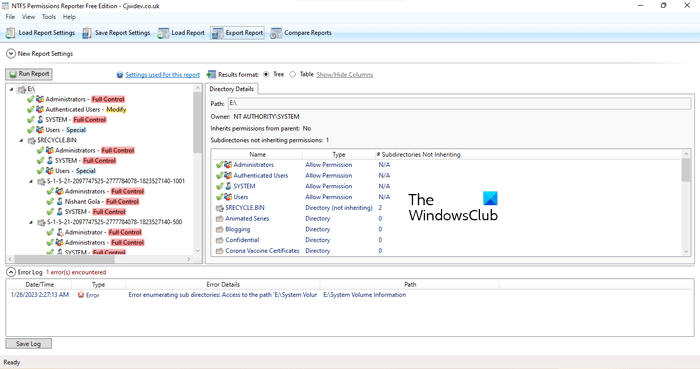
NTFS Permissions Reporter is one more free NTFS permissions checker software on this list. Like other software on this list, it is also available in both free and paid versions. The free version lets you view the NTFS permissions for the selected directory and allows you to access the limited features. After launching the software, select the directory which you want to scan and then click on the Run Report button. After that, it will automatically scan all the folders inside that directory and display the permissions for each folder.
Different formats are available for exporting the project. But the free version users can export the project only in HTML format. To download NTFS Permissions Reporter, visit cjwdev.com.
What are the basic NTFS permissions?
The basic NTFS permissions include Full Control, Read and Execute, Modify, Read, Write, etc. You can check these permissions by opening the properties of a particular folder or drive. After opening the properties, go to the Security tab. You will see all these permissions there. In addition to this, you can also use free software and Windows PowerShell to view NTFS permissions.
Read next: How to take full Ownership of Files & Folders in Windows .
Leave a Reply